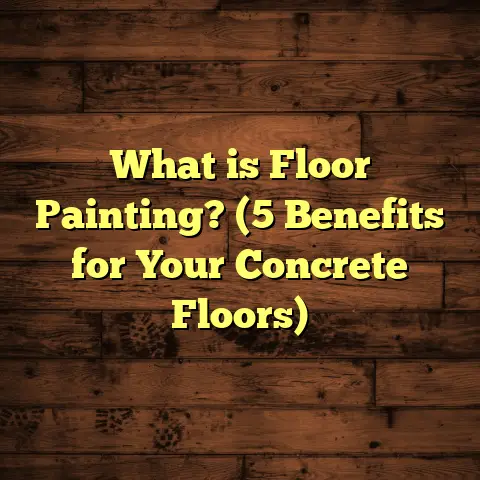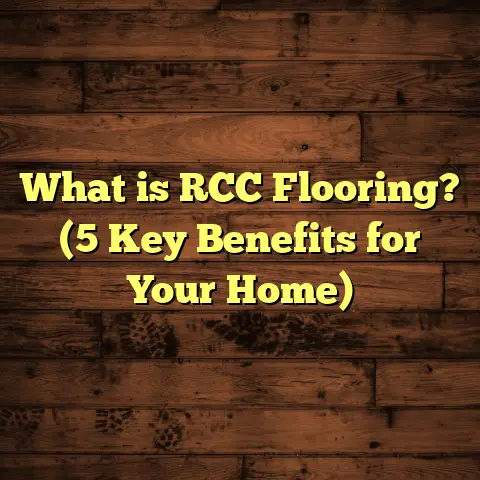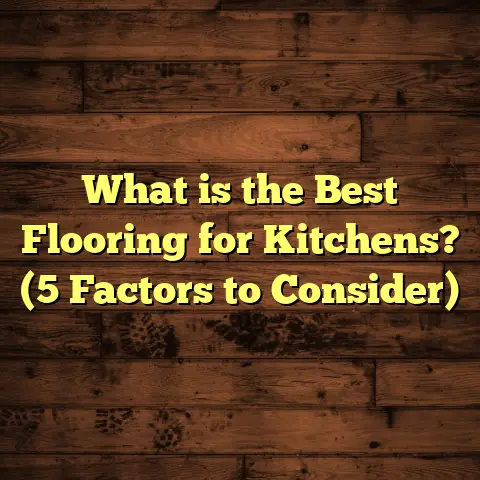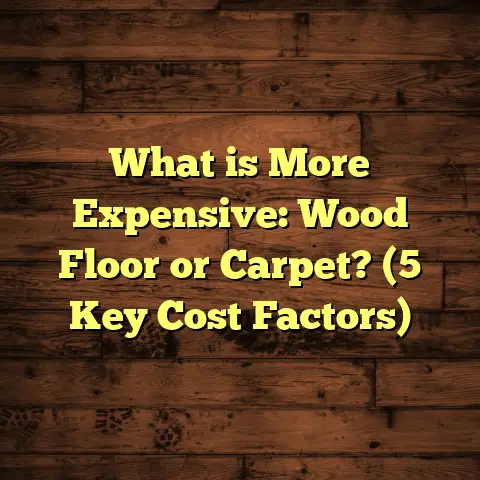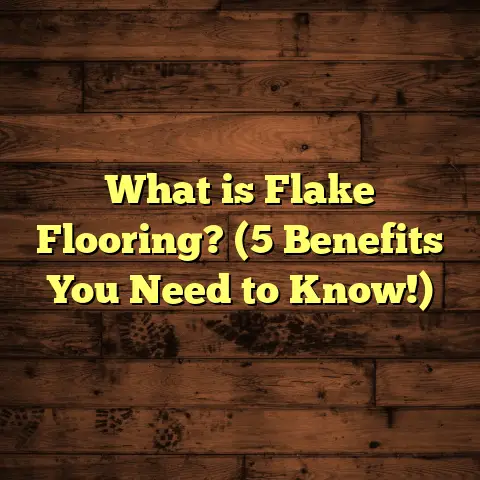What is a Hard Floor? (5 Benefits You Need to Know!)
Spring is right around the corner, and if you’re like me, that means it’s time to start thinking about freshening up the home. One of the biggest ways I’ve found to make a difference in any room is by updating the floors. I’ve spent years working with all kinds of flooring, but there’s something about hard floors that keeps me coming back. They’re stylish, durable, and honestly, pretty easy to live with. If you’ve been wondering exactly what hard floors are and why they might be the right choice for your space, I’m happy to share what I’ve learned.
What Is a Hard Floor?
So, what is a hard floor exactly? At its most basic, a hard floor refers to any flooring surface made from rigid materials rather than soft or fabric-based ones. This usually means surfaces like hardwood, tile, stone, laminate, vinyl planks, or concrete. Unlike carpet or rugs that provide cushioning underfoot, hard floors have a firm feel when you walk on them.
The materials used can vary widely. Hardwood floors come from solid wood planks like oak or maple. Tile and stone options include ceramic, porcelain, slate, or marble. Laminate and vinyl mimic natural textures but are manufactured for durability and affordability. Concrete floors can be polished or stained for a modern look.
When I first started installing floors professionally, I quickly realized that understanding what “hard floor” means helps customers choose wisely based on their lifestyle and tastes. For example, if you have kids or pets, some hard surfaces are easier to clean than others. Or if you’re after a classic look with warmth, real hardwood might be your best bet.
Breaking Down the Types of Hard Floors
- Hardwood: Solid wood planks; warm and timeless.
- Tile/Stone: Durable and water-resistant; great for kitchens/bathrooms.
- Laminate: Budget-friendly alternative that mimics wood/stone.
- Vinyl Planks: Waterproof and versatile; often used in basements or laundry rooms.
- Concrete: Industrial style; can be polished or stained.
I remember one family who wanted something kid-proof but still stylish for their living room. We went with engineered hardwood because it offers real wood beauty with enhanced durability against moisture and scratches. Their floors have held up beautifully for over five years now.
Why Do People Choose Hard Floors?
I get asked this question a lot when I talk to homeowners who aren’t sure whether they should go with hard floors or softer options like carpet. The answer isn’t always simple because each home—and each person’s needs—are different.
Some people want floors that will last a lifetime without needing much upkeep. Others want something that looks good but can handle the chaos of kids and pets. A few prioritize health aspects like allergies or want something that adds value to their home.
Based on my experience, here are some reasons why hard floors often come out ahead:
- They stand the test of time better than many other options.
- They’re easier to clean, which saves effort daily.
- They offer a range of looks—from rustic wood to sleek stone.
- They improve air quality inside homes.
- They increase property value.
Let me break down these benefits more thoroughly.
1. Longevity That Pays Off
Hard floors can last decades when cared for properly. Hardwood floors, for example, often get better with age and can be refinished multiple times to remove scratches or wear.
According to a study by the National Wood Flooring Association (NWFA), hardwood floors can last 100 years or more if maintained well. That’s a huge value compared to carpet, which usually needs replacing every 7-15 years.
One customer of mine had original hardwood from the 1950s and was amazed to learn it could be restored rather than replaced. The refinishing process brought those boards back to life, saving thousands in renovation costs.
You might wonder: what does refinishing involve?
Refinishing means sanding down the wood surface to remove scratches, dents, or discoloration and then applying a fresh coat of finish (like polyurethane). This restores the floor’s beauty without replacing it entirely.
If you have solid hardwood under older carpet or vinyl in your home, consider hiring a professional to see if refinishing is an option. Sometimes the floor underneath is hidden treasure waiting to shine again.
Even laminate or vinyl flooring can last 20+ years if chosen wisely and maintained well. Tile and stone are even more durable—some ceramic tiles have been found still intact in houses hundreds of years old!
2. Easy Cleaning and Maintenance
If you’re like me and don’t want to spend hours vacuuming or dealing with stubborn stains, hard floors are a blessing. They don’t trap dust or allergens like carpets do, making them a healthier choice for allergy sufferers.
A study by the Asthma and Allergy Foundation of America found that homes with hard flooring had significantly lower indoor allergen levels compared to those with wall-to-wall carpeting.
Think about how much dust and dirt gets trapped in carpet fibers—especially if you have pets shedding fur daily or kids playing outside then running around indoors.
With hard floors:
- Sweeping or vacuuming takes just minutes.
- Mopping with water or gentle cleaners keeps surfaces spotless.
- Spills wipe up easily before stains set in.
- There’s no need for professional steam cleaning every year.
Personally, I use a microfiber mop daily in my kitchen and living room because it picks up dust quickly without scratching the floor. Every few weeks I’ll deep clean with a steam mop or recommended wood floor cleaner for hardwood.
Here’s a practical tip: always avoid harsh chemicals or abrasive tools on hardwood floors because they can damage the finish. Instead, use pH-neutral cleaners designed for your floor type.
3. Style Flexibility for Any Room
One thing I love about hard floors is how well they fit into different design styles. Whether you want rustic farmhouse charm with wide plank oak or sleek modern vibes with polished concrete, there’s a hard floor option for you.
I once helped a client who loved Scandinavian minimalism pick out light-colored laminate that looked like real ash wood but was budget-friendly and easy to install themselves.
Plus, hard floors work well with area rugs if you want to add warmth or texture without committing to carpet everywhere.
What’s fun is how many possibilities there are:
- Warm Woods: Hickory, walnut, cherry—each offers unique grain patterns and hues.
- Cool Stones: Slate or marble add elegance and cool tones.
- Modern Vinyls: Mimic wood or stone but come in bold colors or patterns.
- Textured Tiles: Add tactile interest through embossing or varied finishes.
There’s also engineered hardwood—a hybrid that pairs thin wood veneers over plywood for stability in humid climates (great if you live somewhere with drastic weather changes).
It’s amazing how flooring alone can set the tone for your entire room’s vibe.
4. Better Indoor Air Quality
You might not realize it, but carpets trap dust mites, pet dander, mold spores, and other allergens that affect air quality inside your home.
Research shows that hard flooring reduces these allergens because there’s nowhere for them to hide. Regular cleaning simply removes them from the surface rather than embedding them deep into fibers.
I’ve noticed families with asthma or allergies often report fewer symptoms after switching from carpet to hard floors — something worth considering if health is a priority.
One particular family I worked with had two young children with severe allergies. After replacing carpet in their bedrooms with bamboo flooring—a sustainable hardwood alternative—they noticed drastic improvements in breathing within weeks.
This doesn’t mean carpets are bad—it just means they require diligent cleaning and aren’t ideal if anyone in your household has respiratory issues.
If you want extra peace of mind:
- Use doormats at entrances to catch dirt before it spreads.
- Clean floors regularly using HEPA-filter vacuums designed for allergens.
- Consider air purifiers alongside hard flooring for maximum effect.
5. Increased Home Value
Hard floors tend to boost resale value more than carpeted surfaces do. According to Remodeling Magazine’s Cost vs. Value Report, installing hardwood floors recoups an average of 70-80% of the project cost at resale.
Buyers often see hardwood as a sign of quality and longevity in a home, making properties more attractive on the market.
One homeowner I worked with upgraded their main living areas from carpet to engineered hardwood before listing their house. They received multiple offers above asking price within days — proof that good flooring really pays off.
If you’re planning to sell within the next few years:
- Investing in durable hard floors could increase your asking price.
- It also reduces buyer hesitation since flooring replacements are costly.
- Neutral tones and classic styles appeal to wider audiences.
I always recommend homeowners think about flooring early in the selling process because first impressions matter deeply in real estate.
The Environmental Angle: Sustainability of Hard Floors
You might ask: how sustainable are these materials? It’s an important question as more homeowners want eco-friendly options.
Hardwood & Engineered Wood
Good news—wood is renewable when sourced responsibly. Many manufacturers now use certified lumber from sustainably managed forests (look for FSC certification).
Engineered wood uses less solid wood per plank but still offers natural beauty. It often has smaller environmental footprints due to efficient production methods.
Bamboo Flooring
Bamboo grows rapidly compared to traditional hardwood trees—sometimes reaching maturity in 5 years versus decades. This makes it one of the more sustainable choices available today.
Tile & Stone
Natural stone is abundant but quarrying has environmental impacts from energy use and habitat disruption. Ceramic tiles are made from clay baked at high temperatures requiring energy but last very long — offsetting their initial footprint over time.
Vinyl & Laminate
These synthetic products often contain plastics derived from fossil fuels and may not be biodegradable. However,
many brands now offer recycled content options or low-VOC emissions improving indoor air quality.
Real-Life Case Studies: How Hard Floors Perform Over Time
Here are three examples from actual projects I’ve been involved in that show how different types of hard floors hold up in everyday life:
Case Study 1: Family Home with Young Kids & Pets
Material: Engineered Hardwood (White Oak)
Challenge: High traffic areas prone to scratches + spills
Result: After 3 years, the floor shows minor wear but no major damage. Routine sweeping & refinishing every 5 years planned. Parents love how easy cleanup is compared to previous carpets that trapped stains.
Case Study 2: Urban Apartment with Busy Professionals
Material: Polished Concrete
Challenge: Need durable & low-maintenance floor that suits industrial aesthetic
Result: Concrete looks great after 5 years; simple mopping keeps it clean; no scratches despite heavy furniture movement; cooler feel appreciated during summer months but rugs added for warmth in winter.
Case Study 3: Historic House Renovation
Material: Reclaimed Hardwood Flooring
Challenge: Preserve historic charm while updating durability
Result: Floors restored beautifully; original character maintained; refinished twice since installation; owners receive compliments regularly; increased property value by estimated 8%.
Comparing Hard Floors With Other Flooring Types
How do hard floors stack up against other popular options like carpet or soft vinyl?
| Feature | Hard Floors | Carpet | Soft Vinyl |
|---|---|---|---|
| Durability | High (decades) | Medium (7-15 years) | Medium (10-20 years) |
| Maintenance | Easy (sweeping/mopping) | Frequent vacuuming | Easy (mopping) |
| Allergy-Friendly | Yes | No | Yes |
| Comfort Underfoot | Firm | Soft | Softer than hard floor |
| Installation Cost | Moderate to high | Low to medium | Low to medium |
| Resale Value | High | Low | Moderate |
| Water Resistance | Tile/vinyl/concrete good | Poor | Good |
If comfort is your biggest concern, carpet wins hands down. But if you want durability, style variety, and fewer allergens, hard floors are tough to beat.
How To Choose The Right Hard Floor For Your Home
Choosing between hardwood, tile, laminate, vinyl, or concrete depends on several factors unique to your needs:
- Budget: Hardwood tends to be pricier upfront but lasts longer; laminate & vinyl offer budget-friendly options.
- Room Use: Wet areas need water-resistant tile or vinyl; living rooms benefit from warm hardwood.
- Lifestyle: Pets & kids? Look for scratch-resistant finishes and easy cleaning surfaces.
- Aesthetic: Consider color palettes & textures that complement your home design.
- Installation: Some materials require professional installation (hardwood), others are DIY-friendly (laminate).
I always suggest getting samples of different flooring types at home before deciding because lighting dramatically changes how colors appear.
Tips for Maintaining Hard Floors Long-Term
Owning hard floors means some care but nothing too complicated:
- Use felt pads under furniture legs.
- Wipe up spills immediately.
- Sweep/dust regularly.
- Avoid excessive water on wood floors.
- Refinish hardwood every 7-10 years depending on wear.
- Use rugs in high-traffic zones.
- Avoid sharp objects or shoes that can scratch surfaces.
By following these tips, your floors will look great for decades—and save money on replacements!
Final Thoughts: What Makes Hard Floors Worth It?
Having installed hundreds of floors myself and helped dozens of families make choices they love years later, I’m confident in saying hard floors offer unmatched combination of beauty, practicality, health benefits, and value.
They aren’t perfect for everyone—if soft comfort is your number one priority then carpet or cushioned vinyl might be better—but if you want something durable that improves air quality and stands the test of time while looking amazing? Hard floors should be at the top of your list.
If you want help figuring out which type suits your space best or have questions about installation/maintenance costs feel free to ask! After all these years in flooring, nothing beats chatting about what makes floors truly work for real homes like yours.
I hope this detailed guide helps you understand what a hard floor really is and why so many people choose it for their homes every year!
If you want me to drill down into any specific material type next—like pros/cons of vinyl vs laminate—just say the word!
